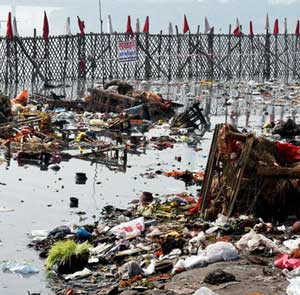Agra, home to the iconic Taj Mahal and over two million residents, faces a water crisis of unprecedented proportions. The sacred Yamuna River, once the lifeblood of the city, now lies choked and poisoned, a victim of systemic neglect, unchecked urbanisation, and political indifference.
The Ganga Jal Pipeline has provided temporary relief, but the Yamuna’s plight remains a stark symbol of ecological collapse. Says green activist Rahul Raj, “The Yamuna, once worshipped as a goddess, has been reduced to a toxic drain. Its tributaries are nearly extinct, and its waters are unfit for life.”
Environmentalist Dr Debashish Bhattacharya explains, “The Okhla Barrage diverts most of the Yamuna’s flow upstream, leaving Agra with a skeletal stream. Downstream, the river becomes a dumping ground for untreated sewage and industrial waste from Delhi. Chemical foam floats on its surface, and dead fish are a grim reminder of its ecological death.”
The crisis extends beyond the river. Agra’s historic ponds, once vital for monsoon rainwater storage and community use, are vanishing under concrete and garbage. Chaturbhuj Tiwari of the River Connect Campaign notes, “Nearly 1,000 ponds have been lost to encroachment and neglect. These water bodies, integral to Agra’s cultural and ecological heritage, are now barren wastelands.”
For Agra’s residents, the consequences are dire. The Agra Jal Sansthan struggles to meet water demand, leaving taps dry for hours. In slums and Trans-Yamuna colonies, women queue for hours at community pumps, while farmers watch their crops wither as borewells run dry. Toxic water has led to a surge in waterborne diseases, compounding the city’s suffering.
Even the Taj Mahal, Agra’s crown jewel, is under threat. Green activist Padmini Iyer warns, “The dry, polluted Yamuna is weakening the monument’s wooden foundation, jeopardising its structural integrity and the tourism economy it supports.”
Despite the grim scenario, there is hope. Members of the River Connect Campaign advocate for interstate cooperation to clean the Yamuna, including strict waste control in Delhi, reviving tributaries, and curbing illegal sand mining. Locally, the Agra Municipal Corporation can restore community ponds by removing encroachments and promoting rainwater harvesting.
Anil Sharma of the Agra Civil Society emphasises, “Rooftop rainwater collection systems and public awareness campaigns can alleviate groundwater stress. Farmers must adopt water-efficient methods like drip irrigation.”
As Agra’s water crisis reaches a breaking point, the city’s fate hangs in the balance. The time for action is now, before the tears of the Taj run dry forever.


















Related Items
How political parties became corporates…!
Bihar: In whose favour the political wind blowing…?
Same question this year...! Where has all the rainy water gone…?